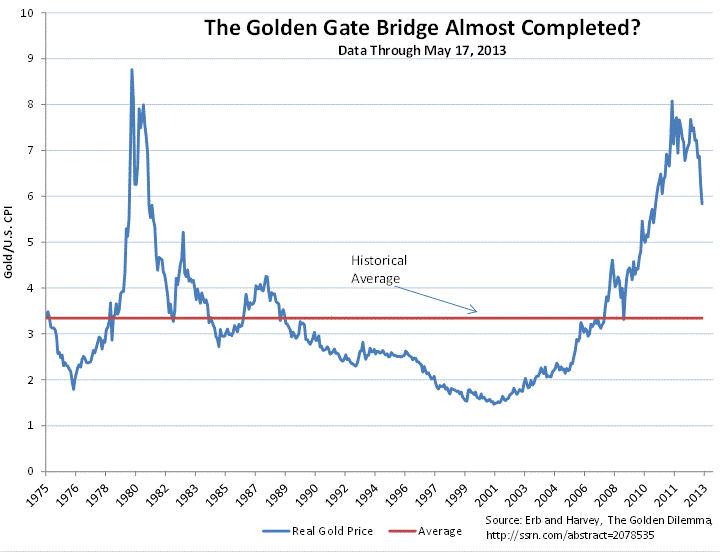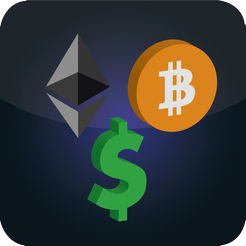On August 23, 2011, the price of gold reached $1,913.50. Today the price is $1,450 – a drop of over 25%. What is going on? Why should we care?
In June of 2012, we [this post is co-written with Claude Erb] released a controversial academic study based on a comprehensive historical analysis that claimed that the fair price of gold was $800. This number seemed unfathomable back in June. Ten months later, it is a different story.
So how do you determine the fair price of gold?
Obviously, there is no precise formula. With stocks, we usually look at a value indicator, like the Price-to-Earnings (PE) ratio. A PE ratio of 30 is expensive. A PE ratio of 5 is cheap.
With gold, a natural benchmark is inflation. Our research shows that over the very long term, gold moves with inflation.
Let’s consider a few examples from history.
In 562 B.C., during the reign of the Babylonian king Nebuchadnezzar, an ounce of gold purchased 350 loaves of bread. Given the current price of gold, that works out to about $4 a loaf. Yes, you can get a cheaper loaf of bread – but the bread that many of us buy at a local bakery is that price.
The second example is more powerful because it focuses on wages. We tried to find a job 2000 years ago that we could compare with today. We ended up looking to the military.
In the era of Emperor Augustus (27 B.C. to 14 A.D.), a Roman Centurion was paid 15,000 sestertii. Given that 1 gold aureus=1000 sertertii and given there is 8 grams of gold in an aureus, the pay comes to 38.58 ounces of gold. At current prices, this is about $56,000 per year.
The Centurion who commanded 80 Legionaries is roughly equivalent to a U.S. Army Captain. The current wage for a Captain is $46,000 – which is fairly close.
This implies that gold is a good store of value. Essentially, gold is a good inflation hedge – but our examples are over the very, very, very long term, more than 2,000 years.
Our paper looked at the price of gold over history and noted that when the “real” price (adjusted for inflation) rose above its average, it usually reverted lower.
We calculated that the fair price, based on the level of inflation in 2012, was $800. The market price in 2012 was far higher. We also documented that, in the past, when you purchase gold when the real price is high, the future returns are very low.
Why is this important?
Investors (both individual investors and institutional investors) make the assumption that gold is an inflation hedge. Many institutional investors buy gold to fulfill their mandate to protect against inflation.
However, our paper shows that gold is an awful inflation hedge for investors.
Gold is a good inflation hedge if your investment horizon is measured in centuries – not years.
There is a simple reason. Gold prices are extremely volatile. Inflation is not volatile. As a result, gold is an unreliable hedge for inflation. Our paper shows that even with a 20-year horizon, gold is a terrible inflation hedge.
So where are we?
First, don’t expect an investment in gold to provide an inflation hedge. We are not saying ‘don’t hold any gold’. Our research also shows that a diversified portfolio of commodities (which includes gold) can provide a good inflation hedge over reasonable investment horizons.
Second, beware of buying gold when the inflation-adjusted price is high. Historically, the fair price of gold is closer to $800 than $1,450.
For more detail, read our paper, The Golden Dilemma.





Cam,
Correct me if my conclusions are inaccurate, but on one hand you make the argument that, based on the level of inflation, the fair price of gold is close to $800, while on the other you state that the price of bread and the salary of a military captain paid for in gold centuries ago is close to today’s price of $1450.
Gordon,
Good comment.
Essentially my example says that the “real” return on gold over the long term is very close to zero. When you compound with an exponent of 2000 the rate of return is very low.
If this was “exact” – i.e. Centurion and Captain the same, the price of gold would be $1200. Which is considerably below today’s price.
I like the general intuition that gold is a good store of value but only reliable in the very, very long term.
Thanks for your insight.
Cam,
Perhaps the investment benchmark should compare the return on gold to the return on a portfolio of developed and developing economies government debt securities weighted ratably by global GDP and market value. My intuition leads me to suspect that gold assumes the risk-free return over long horizons, but I have not investigated. Perhaps, gold (and other precious metals, commodities, etc) are simply the only true risk-free assets over the next decade.
Corey
Cam,
Perhaps the investment benchmark should compare the return on gold to the return on a portfolio of developed and developing economies government debt securities weighted ratably by global GDP and market value. My intuition leads me to suspect that gold assumes the risk-free return over long horizons, but I have not investigated. Perhaps, gold and other precious metals and commodities, etc are simply the only true risk-free assets over the next decade.
Corey
This is essentially the argument made by Robert Barro in a recent working paper. I have the following problems with this.
1. It is hard to call something with 14% annual vol “risk free” (even if it is generally uncorrelated with popular factors). Even with time diversification, i.e. using 50 year horizons there is considerable volatility.
2. Given that gold has been around so long, even a small expected rate of return over the long-term doesn’t make sense. Suppose you think of a small rate like the 10-year bond rate to day, 1.6% (which is historically very low). You compound a dollar back in Roman times at 1.6% and you end up with $61 trillion today – more than the value of equity markets world wide. This is another way of viewing my Roman Centurion example.
Overall, there is an important role for “real” assets for any investor. My research paper does not say you should not hold gold. Indeed, my other research on commodities argues that investors should hold diversified commodity portfolios. That provides an effective hedge against unexpected inflation. Gold is part of a well diversified commodity portfolio.
Cam:
How about just a simple bet between you and me for a quarter ounce of gold? I bet gold hits $2100 before it hits $800. The loser puts it in the mail that day.
And you have the benefit of government scared to death of the price of gold, doing its level best to manipulate that price down to save the remaining value of its dollar. I merely can count on the integrity of the market to attempt to defy that incredible printing force against it. But we are in uncharted territory where naively arrogant big government boldly drags its brothers and sisters further out on the limb every day.
Are you sticking to theory or wld you like to talk in real value terms? I’m in if you are in, sir. It is your move.
– Ted
Ted Alexander
Fuqua ’97
Take a look at my paper at https://ssrn.com/abstract=2078535 . The idea is that over the very long term, the real price of gold is approximately constant. Currently, the “real” price of gold is high. Historically, we have seen mean reversion. Of course, history does not necessarily repeat itself. It is possible that “this time is different”. If the spot price of gold reverted to the mean, the price would be $800. If gold generally moves with inflation, the spot price could go further with a bout of unexpected (positive) inflation. Who knows, the price could go way further up. My point focuses on the real price of gold.